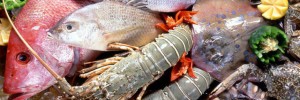How to store fish and shellfish safely
Fish can be purchased fresh, frozen, canned, or cured. Each style has its own storage requirements, but it is important to stress once again that all fresh fish and shellfish are highly perishable and require that precautions be taken to ensure freshness. Although proper preparation helps to destroy microorganisms that occur naturally or are introduced during handling, fish, and especially shellfish, must be stored properly to reduce the risk of foodborne illness.
Fresh Fish
Fresh fish are best consumed within a day or two of purchase. Fish flesh is much more perishable than animal tissue for several reasons. One of these is that all raw seafood carries some bacteria, which multiply rapidly above 40°F (4°C). For this reason, fish should be stored in the coldest section of the refrigerator. It should also be tightly wrapped to prevent odors from coming in contact with other foods. Fish bought wrapped in butcher paper should be rewrapped in plastic wrap and then aluminum foil, but prepackaged fish and shellfish can be left in the original package. Any exposure to oxygen increases perishability, because the high levels of polyunsaturated fatty acids in fish can be oxidized into compounds that affect odor and taste. Caviar is particularly sensitive to oxygen and cannot be left out in the air for more than one hour. Unopened caviar can be stored in the refrigerator for up to three months, but once opened, it should be consumed within three days.
Other factors that can contribute to spoilage are proteolytic enzymes, natural toxins, and contaminants. Proteolytic enzymes break down muscle proteins and provide amino acids for bacterial growth. Bacterial enzymes can also break down proteins to amino acids and elevate the levels of histamine, a toxin. Excessive consumption of histamine leads to a foodborne illness known as scombroid poisoning or scombrotoxism. Excessive histamine may accumulate in tuna, tuna-like fish, mahi-mahi, bluefish, and other species that usually have not been chilled immediately after being caught.
It is a good practice to eat fresh shellfish the day they are bought. If they must be kept, the storage requirements are varied and depend on the type of shellfish. Most fresh shellfish may be kept alive in cool, salty, wet environments, preferably in the refrigerator. Storing fresh shellfish on ice may kill them if they become submerged in fresh water from the melting ice. Live oysters, clams, and mussels should be well aerated in the refrigerator and not stored in plastic bags or in fresh water, where they will die. Any dead animals, indicated by an open shell or no response when tapped, should be discarded. Crabs, usually sold precooked, should be stored in the coldest pan of the refrigerator and used within a day or two. Once cooked, all crustaceans must be refrigerated at temperatures below 40°F (4°C) and consumed within two days.
Raw Fish. The Centers for Disease Control warns about the hazards of eating raw fish or shellfish. This is particularly true for pregnant or nursing women, the very young, the elderly, and anyone with a serious illness or compromised immune system. Not only bacteria and viruses, but parasites as well, may pose a problem. Mollusks are particularly prone to carry contaminants, because they are filter feeders whose usual habitat is in shallow waters, which are more likely to be subject to bacterial, viral, and chemical pollution. Consuming, or even shucking, raw oysters is a potential concern because they may carry Vibrio vulnificus, V cholera, V parahaemolyticus, Norwalk virus, or hepatitis A.
Raw fish (sashimi) used in sushi (rice item) and ceviche should be carefully checked by trained cooks for aniskiasis parasites, which are the width and color of white thread. Ceviche is raw fish that has been prepared by an acid marination, lemon or lime juice based, that denatures the proteins and turns the flesh white. This type of preparation does not involve heating, and thus the fish should still be considered “raw” and treated accordingly. Only heating to 145°F (63°C) for at least one minute or freezing the fish in a commercial freezer to -10°F (14°C) for seven days ensures destruction of aniskiasis parasites.
Frozen Fish
The frozen-foods industry in North America began with fish because of Clarence Birdseye’s accidental discovery while ice fishing. Freezing greatly extends the keeping time of fish which, depending on the type, can be stored in the freezer up to nine months. It is absolutely necessary, in order to arrest microbial growth, to freeze fish if they are not cleaned (eviscerated) within 24 hours of being caught. Once cleaned, the general rule is that lean fish keep longer than fatty fish. Fish should be stored at 0°F (-18°C) or below and never refrozen once thawed. Prepackaged and frozen fish can stay in the original wrappers but should be kept airtight in order to prevent them from drying out. Breaded frozen fish, or fish fillets or steaks weighing less than pound, should not be thawed before cooking because they will become mushy. Frozen, raw shellfish can also be prepared from the frozen state, while frozen precooked shellfish can be used as is after thawing. Fish is best thawed by transferring it from the freezer to the refrigerator one day before preparation; once thawed, it should be cooked immediately. Even though it is the most healthful and popular method of preserving fish, freezing tends to cause a reduction in quality, making it dryer, tougher, less springy, and possibly affecting the flavor.
Canned and Cured Fish
Canned fish can stay on the shelf for up to twelve months, but any dented, damaged, or bulging cans should be discarded. Unused fish from an opened can should be moved to a covered glass or plastic container and can be stored for up to a week in the refrigerator. Cured fish can be refrigerated, frozen, or canned.
